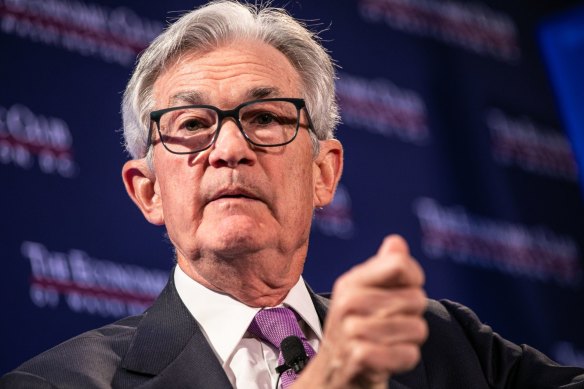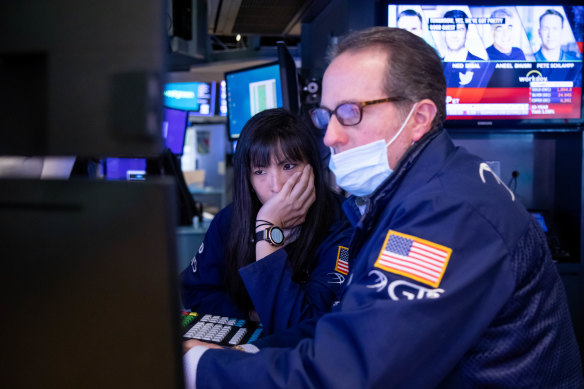ASX set to fall as Fed chief rattles Wall Street with rates talk
By Stan Choe
Stocks are falling on Wall Street on Tuesday after the head of the Federal Reserve warned it could speed up its economy-crunching hikes to interest rates if pressure on inflation stays hot.
The S&P 500 was 1.1 per cent lower in early-afternoon trading. The Dow Jones fell 1.4 per cent while the Nasdaq composite was 0.7 per cent lower. The Australian sharemarket is set to open sharply lower, with futures at 5.01am AEDT pointing to a fall of 47 points, or 0.6 per cent, at the open.

Inflation and what the Fed is doing about it have been at the centre of Wall Street’s sharp swings this year. After seeming to be on a steady decline since last summer, reports on inflation last month came in surprisingly hot. So did a suite of other data on the economy, including the job market and spending by US consumers.
That raised fears on Wall Street that inflation is staying stickier than feared and that the Fed will have to raise rates higher than earlier thought. Higher rates can drag down inflation because they slow the economy, but they hurt prices for stocks and other investments. They also raise the risk of a recession later on.
Its chair, Jerome Powell, on Tuesday confirmed those expectations and said the recent data mean “the ultimate level of interest rates is likely to be higher than previously anticipated.” He also said in his testimony to a Senate committee that the Fed is ready to increase the pace of its hikes again if needed.
That would be a sharp turnaround after it had just slowed its pace of increases to 0.25 percentage points last month from earlier rate hikes of 0.50 and 0.75 points.
“If the totality of the data were to indicate that faster tightening is warranted, we would be prepared to increase the pace of rate hikes,” Powell said. “Restoring price stability will likely require that we maintain a restrictive stance of monetary policy for some time.”
After sitting at virtually unchanged levels just before Powell’s testimony, stocks fell immediately afterward.
Wall Street had already been convincing itself that higher rates than earlier thought were on the way and that the Fed may even possibly go back to larger rate increases following last month’s data reports.
Since getting last month’s blowout jobs report and other surprisingly strong data, Wall Street has largely abandoned hopes that percolated early this year for a possible cut to interest rates later in 2023. It also upped its forecast for how high the Fed will ultimately take rates before pausing.

That’s been most clear in the bond market, where the yield on the 10-year Treasury topped 4 per cent last week and hit its highest level since November. It helps set rates for mortgages and other important loans.
On Tuesday, it again approached 4 per cent after Powell’s comments before falling back to 3.96 per cent, where it was late Monday.
The two-year yield, which moves more on expectations for the Fed, climbed to 4.94 per cent from 4.87 per cent and is near its highest level since 2007.
Traders now see roughly even odds that the Fed’s next rate increase will be either another move of 0.25 percentage points or that it will accelerate back to 0.50 percentage points. Just a day earlier, they were betting on a roughly two-out-of-three probability for the smaller increase, according to data from CME Group.
More fireworks may arrive later this week and into next as the Fed gets more data points that will surely help shape its decision-making ahead of its next meeting on interest rates later this month.
On Friday will come the US government’s monthly jobs report. Within that, most of the attention will be on how high wages are going for workers. The fear at the Fed is that too-strong gains could lead to more upward pressure on inflation.
Then two reports next week will give updates on how high inflation remains at both the consumer and at the wholesale levels.
The big shifts among investors about where inflation and the Fed are heading have led to sharp movements for markets. In January, stocks rallied and bond yields eased as hope blossomed that inflation would cool and get the Fed to take it easier on interest rates. Then, last month’s torrent of strong data dashed those expectations and sent stocks falling and bond yields jumping.
On Wall Street Tuesday, WW International, better known as WeightWatchers soared after saying it’s getting into the prescription weight loss business with the purchase of telehealth platform Sequence. WW will pay $US106 million ($161 million) for Sequence, which served about 24,000 members across the US as of February.
Shares of WW jumped 42.4 per cent.
Stock markets abroad were mixed.
Most Viewed in Business
Source: Thanks smh.com